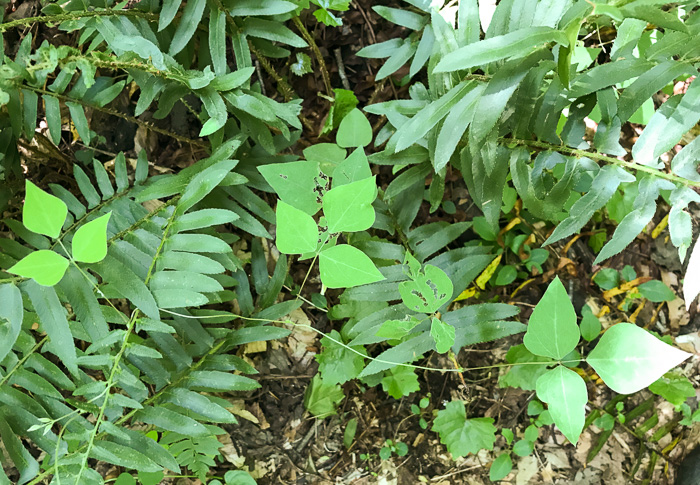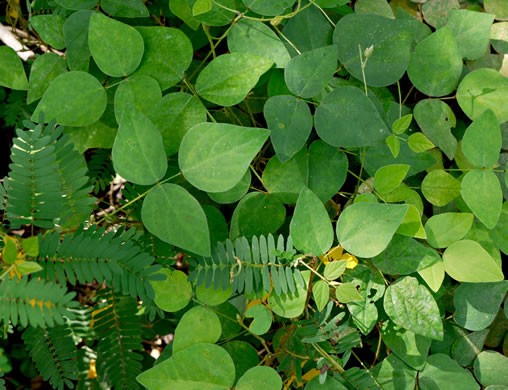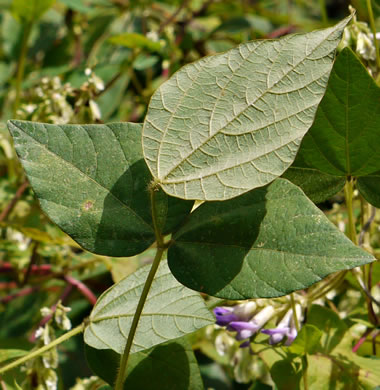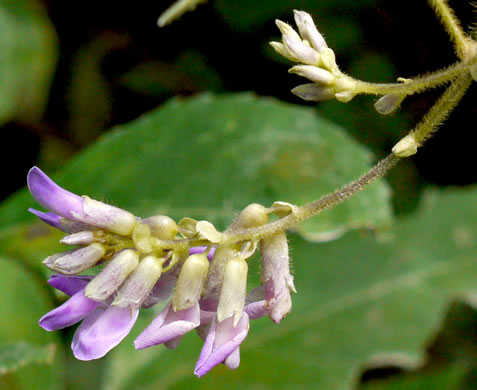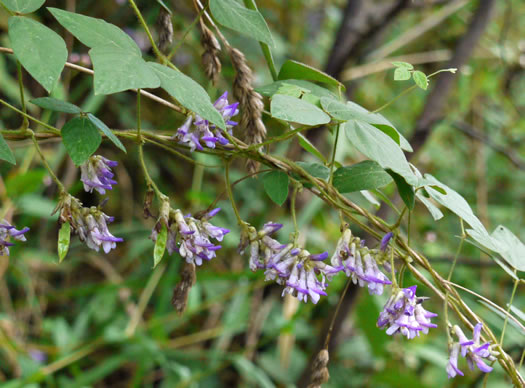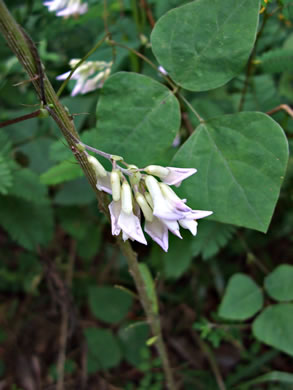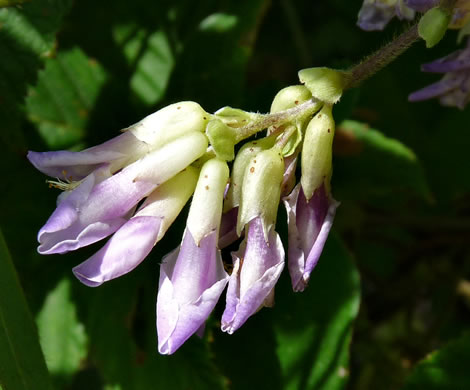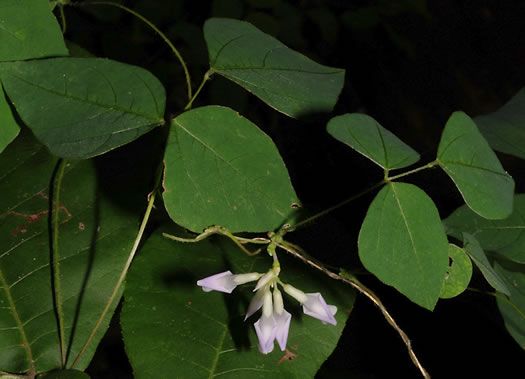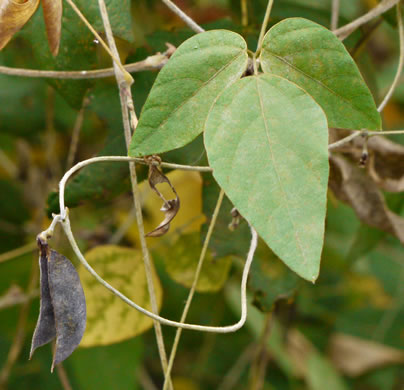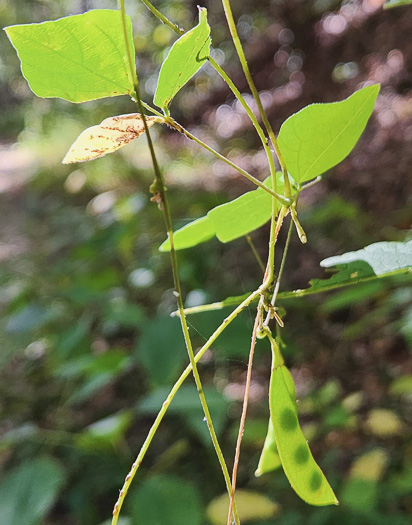Spermatophytes (seed plants): Angiosperms (flowering plants): Eudicots: Core Eudicots: Rosids: Fabids: Fabales
WEAKLEY'S FLORA OF THE SOUTHEASTERN US (2/10/25):
Amphicarpaea bracteata +
FAMILY
Fabaceae
Go to FSUS key
Dig deeper at SERNEC, a consortium of southeastern herbaria.
An herbaceous vine with a slender stem that twines up to 3-5 feet long or high. The leaves are alternate on the stem, with each of the 3 leaflets being ovate to nearly triangular, with strongly rounded bases and a tapered tip.... The leaflets have hairs that are flattened to both the upper and lower leaf surfaces, a helpful identification key in separating this species from Thicket Bean (Phaseolus polystachios). Learn more Vascular Plants of North Carolina.
The distributions and habitats of the two or more varieties in our area require herbarium and field investigation, per Weakley's Flora (2025)
INCLUDED WITHIN
PLANTS NATIONAL DATABASE:
Amphicarpaea bracteata
FAMILY
Fabaceae
INCLUDED WITHIN Flora of North America north of Mexico, vol. 11 (2023)
Amphicarpaea bracteata
INCLUDED WITHIN Floristic Synthesis of North America. BONAP (Kartesz, 2021)
Amphicarpaea bracteata
INCLUDED WITHIN Native & naturalized Leguminosae (Fabaceae) of the US (Isely, 1998)
Amphicarpaea bracteata
INCLUDED WITHIN (ORTHOGRAPHIC VARIANT VASCULAR FLORA OF THE CAROLINAS (Radford, Ahles, & Bell, 1968) 098-49-001:
Amphicarpa bracteata FAMILY Fabaceae
SYNONYMOUS WITH (ORTHOGRAPHIC VARIANT) Britton & Brown Illus Flora of Northeast US & adjacent Canada (Gleason, 1952)
Amphicarpa bracteata +
INCLUDING & INCLUDED WITHIN Manual of the Southeastern Flora (Small, 1933, 1938)
Falcata comosa
COMMON NAME:
American Hog-peanut
To see larger pictures, click or hover over the thumbnails.
JK Marlow jkm140816_747
August Jackson County NC
High Hampton Inn
Leaflets ovate to rhombic-ovate, the lateral often assymmetrical, per Vascular Flora of the Carolinas (Radford, Ahles, & Bell, 1968).
![]() COMPARE
leaves that are trifoliolate and pinnately compound
COMPARE
leaves that are trifoliolate and pinnately compound
JK Marlow jkm140906_252
September Swain County NC
Racemes from upper axils nod on slender peduncles mostly 1-6cm long, per Vascular Flora of the Carolinas (Radford, Ahles, & Bell, 1968).
Roxanna Martin rlm9109_024
September Spartanburg County SC
Racemes of 1-17 petaliferous flowers, per Vascular Flora of the Carolinas (Radford, Ahles, & Bell, 1968).
Richard and Teresa Ware rtw_a_bracteata
September
Calyx narrowly campanulate, tube 4-6mm long, upper 2 lobes united or nearly so, per Vascular Flora of the Carolinas (Radford, Ahles, & Bell, 1968).
Dan Whitten sdw_100623_amphicarpaea
October Greenville County SC
Chestnut Ridge Heritage Preserve
Legume from petaliferous flowers is flattened, olong-linear, 1.5-4cm long, per Vascular Flora of the Carolinas (Radford, Ahles, & Bell, 1968).
WEAKLEY'S FLORA OF THE SOUTHEASTERN US (2/10/25):
Amphicarpaea bracteata +
FAMILY
Fabaceae
INCLUDED WITHIN
PLANTS NATIONAL DATABASE:
Amphicarpaea bracteata
FAMILY
Fabaceae
INCLUDED WITHIN
Flora of North America north of Mexico, vol. 11
Amphicarpaea bracteata
INCLUDED WITHIN
Floristic Synthesis of North America. BONAP (Kartesz, 2021)
Amphicarpaea bracteata
INCLUDED WITHIN
Native & naturalized Leguminosae (Fabaceae) of the US (Isely, 1998)
Amphicarpaea bracteata
INCLUDED WITHIN (ORTHOGRAPHIC VARIANT
VASCULAR FLORA OF THE CAROLINAS (Radford, Ahles, & Bell, 1968) 098-49-001:
Amphicarpa bracteata
FAMILY
Fabaceae
SYNONYMOUS WITH (ORTHOGRAPHIC VARIANT)
Britton & Brown Illus Flora of Northeast US & adjacent Canada (Gleason, 1952)
Amphicarpa bracteata +
INCLUDING & INCLUDED WITHIN
Manual of the Southeastern Flora (Small, 1933, 1938)
Falcata comosa
If a search such as "Carex leptalea var. leptalea" doesn't deliver the results you want, try "Carex leptalea".
Or, to minimize chances of a misspelling, try just "Carex le".
Less is more: If "pencil flower" doesn't deliver the results you want, try "pencil".

